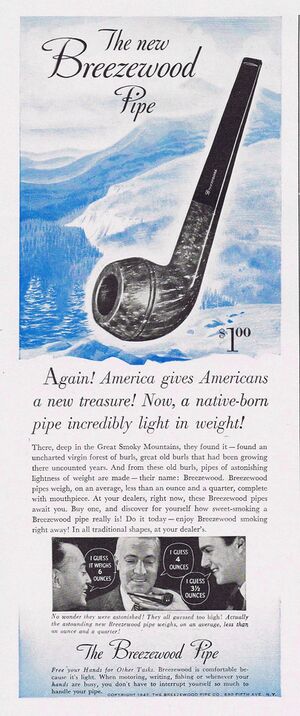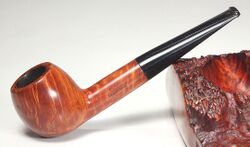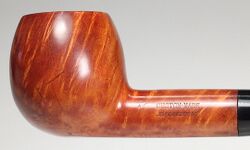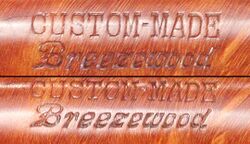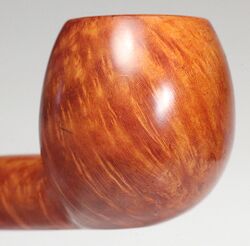Breezewood: Difference between revisions
(Created page with "Breezewood is a brand which appears to come into existence at least as early as 1942, as we have an advertisement from that year. During WWII it was very difficult for U.S. pi...") |
No edit summary |
||
| (One intermediate revision by one other user not shown) | |||
| Line 1: | Line 1: | ||
[[File:Breezewood13.jpg|thumb|1942 Ad, courtesy Doug Valitchka]] | |||
There was controversy about the use of Mountain Laurel, thinking it was poisonous, and it is for certain animals to eat it, but not to use it to make pipe bowls from. But after the war, and regular overseas supplies of briar became available, it became very common for U.S. pipe makers to stamp their bowls with IMPORTED BRIAR, so as to distinguish it from the | [[Breezewood]] is a brand which appears to come into existence at least as early as 1942, as we have an advertisement from that year. During WWII it was very difficult for U.S. pipe companies to get briar, as most of it came from European and Mediterranean areas. So alternatives were creatively used, a popular one being Mountain Laurel, a cousin to the briar plants overseas. The Breezewood ad copy weaves a creative story about this "burl" found in uncharted virgin forests from the Great Smoky Mountains! | ||
There was controversy about the use of Mountain Laurel, thinking it was poisonous, and it is for certain animals to eat it, but not to use it to make pipe bowls from. But after the war, and regular overseas supplies of briar became available, it became very common for U.S. pipe makers to stamp their bowls with IMPORTED BRIAR, so as to distinguish it from the [[Mission Briar]] or other domestic materials. | |||
The ad focuses on the lightness of the pipes, though I'm not sure they were any lighter than most pipes of their day. | The ad focuses on the lightness of the pipes, though I'm not sure they were any lighter than most pipes of their day. | ||
Ad: (C) 1942, THE BREEZEWOOD PIPE CO., 630 FIFTH AVE. N.Y. | Ad: (C) 1942, THE BREEZEWOOD PIPE CO., 630 FIFTH AVE. N.Y. | ||
<gallery widths=250 heights=250 caption="Example and details, courtesy Doug Valitchka"> | |||
Breezewood01.jpg | |||
Breezewood05.jpg | |||
Breezewood07.jpg | |||
Breezewood08.jpg | |||
</gallery> | |||
[[Category:Pipe makers by nationality]] | |||
[[Category:United States]] | |||
Latest revision as of 12:19, 19 December 2022
Breezewood is a brand which appears to come into existence at least as early as 1942, as we have an advertisement from that year. During WWII it was very difficult for U.S. pipe companies to get briar, as most of it came from European and Mediterranean areas. So alternatives were creatively used, a popular one being Mountain Laurel, a cousin to the briar plants overseas. The Breezewood ad copy weaves a creative story about this "burl" found in uncharted virgin forests from the Great Smoky Mountains!
There was controversy about the use of Mountain Laurel, thinking it was poisonous, and it is for certain animals to eat it, but not to use it to make pipe bowls from. But after the war, and regular overseas supplies of briar became available, it became very common for U.S. pipe makers to stamp their bowls with IMPORTED BRIAR, so as to distinguish it from the Mission Briar or other domestic materials.
The ad focuses on the lightness of the pipes, though I'm not sure they were any lighter than most pipes of their day. Ad: (C) 1942, THE BREEZEWOOD PIPE CO., 630 FIFTH AVE. N.Y.
- Example and details, courtesy Doug Valitchka
